

|
Soundclip:
|
| See Steve's Hand-Written Solo
Transcription |
|
Steve Khan's solo on: "Invisible"(Ornette Coleman) From the first time that I heard it, Ornette Coleman's 1958 album, his first as a leader, "SOMETHING ELSE!!!!" was one of my favorites, mostly because of some of the compositions. Tunes like "The Blessing"; "When Will The Blues Leave?"; "The Sphinx"; and of course, "Invisible" stayed with me for years. I don't know that, as a leader, he ever recorded again with a piano. After having spent so many years listening to his music, the music of the great quartets, it is, at times, hard going back and hearing him in a context with a piano. 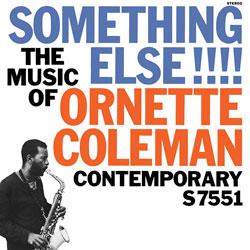 There are times where Ornette sounds boxed-in by the constraints of chordal comping that adheres so strictly to the changes and the bar lines, without the elasticity and freedom that one associates with Ornette's music. Of course, there is no one correct way for other players to interpret his music, for example, I love what David Sanborn did with "Ramblin'," and the immense groove set-up by Marcus Miller and Steve Jordan. Ornette's music, in the right hands, can sound great that way too! There are times where Ornette sounds boxed-in by the constraints of chordal comping that adheres so strictly to the changes and the bar lines, without the elasticity and freedom that one associates with Ornette's music. Of course, there is no one correct way for other players to interpret his music, for example, I love what David Sanborn did with "Ramblin'," and the immense groove set-up by Marcus Miller and Steve Jordan. Ornette's music, in the right hands, can sound great that way too!When I began to conceive of my approach to, and my arrangement for, "Invisible," it began as a piece that would only have guitar, baby bass, Latin percussion, and drums, nothing more. But, as I was assembling my demo, and using my keyboard controller, an old Yamaha DX-7, to enter the musical data, somehow, a montuno came to me, and I began to play it into the computer. At first, I thought that I would be able to play something close to the voicings that I had created on the keyboard using my guitar. But, the more I tried, the more frustrated I became, because it never sounded right, nor felt right. It took me awhile to let go of my original concept for the piece, and I knew that that particular keyboard part would have to be performed by Rob Mounsey. As the arrangement continued to evolve, the role of the keyboard broadened to the level of what it eventually became. Where the statement of the melody is concerned, it is a bit less dense than the keyboard's role on Greg Osby's "Concepticus in C," but certainly no less important. As things worked out, the very last touch I added to the keyboard part was the chordal stabs that appear during the Soli, which, on this tune, appears before Bob Mintzer's wonderful tenor sax solo. Of course, during Bob's solo, there is no real comping, only the occasional overdubbed Strat w/ volume pedal and tremolo arm to add a chordal color here and there. When I had created a solo structure and harmonic format for the traditional 32-bar [A]-[A2]-[B]-[A3] form, I decided that the first 4 bars of each [A] section would only have two chords ascending by a 1/2-step. They were intentionally allowed to be vague in that the soloist could decide to treat them as major chord areas, or as dominant chord areas. 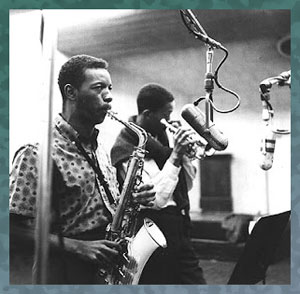 However, when Bob Mintzer decided that he was going to approach them as dominant 7th chords, I decided that I too would go with that approach. And this is now what you hear on the recording. As much as I love listening to Ornette Coleman and Don Cherry play Ornette's melodies together, I have to say that it was a tremendous privilege to play the melody to "Invisible" with Bob. I just love his sound and his phrasing, and it was easy to create a blend with him. Because of the overall structure of the arrangement, the solo sections were labeled as: [D]-[D2]-[E]-[D3]. As for the rhythmic approach, as it was on my original demo, Marc Quiñones agreed that we would play "Invisible" as a Son Montuno. However, Marc and Bobby Allende(conga & bongo) decided to treat the two solo sections from different rhythmic perspectives. Bob Mintzer's solo had Marc playing cáscara for most of the [D] sections, with the campana joining in for both [E] and [D3]. The other percussive element during Bob's solo was the overdubbed maracas. When the guitar solo arrives, Marc made a wonderful shift from cáscara and played the entire solo section with a groove that puts the emphasis on beats 1 & 3 coming from the cha-cha bell. Personally, I love this feel. The overdubbed percussion instrument became the güiro for these sections with no campana ever appearing. The only other crucial detail was that we agreed that drummer Mark Walker would not go to his ride cymbal until the 3rd Chorus of each solo. Yes, there are always a lot of details to be discussed and worked out, but, in the end, it is all worth it! However, when Bob Mintzer decided that he was going to approach them as dominant 7th chords, I decided that I too would go with that approach. And this is now what you hear on the recording. As much as I love listening to Ornette Coleman and Don Cherry play Ornette's melodies together, I have to say that it was a tremendous privilege to play the melody to "Invisible" with Bob. I just love his sound and his phrasing, and it was easy to create a blend with him. Because of the overall structure of the arrangement, the solo sections were labeled as: [D]-[D2]-[E]-[D3]. As for the rhythmic approach, as it was on my original demo, Marc Quiñones agreed that we would play "Invisible" as a Son Montuno. However, Marc and Bobby Allende(conga & bongo) decided to treat the two solo sections from different rhythmic perspectives. Bob Mintzer's solo had Marc playing cáscara for most of the [D] sections, with the campana joining in for both [E] and [D3]. The other percussive element during Bob's solo was the overdubbed maracas. When the guitar solo arrives, Marc made a wonderful shift from cáscara and played the entire solo section with a groove that puts the emphasis on beats 1 & 3 coming from the cha-cha bell. Personally, I love this feel. The overdubbed percussion instrument became the güiro for these sections with no campana ever appearing. The only other crucial detail was that we agreed that drummer Mark Walker would not go to his ride cymbal until the 3rd Chorus of each solo. Yes, there are always a lot of details to be discussed and worked out, but, in the end, it is all worth it!After a reprise of the Intro, [I], Chorus 1 begins with a hit on the and-of-1 using a particular Db7(#9) voicing with Db on top, and leaving out the Ab(5th) just below it. This a voicing that I associate with the piano, and Chick Corea's playing during the mid-'60s. My guitar solo is again, on the most basic of levels, informed by two things: [1] What Bob Mintzer played during his solo, and [2] putting to use ideas that appear in Ornette's melodies. To restate it, Bob Mintzer decided to approach the chords in the 1st 4 bars of the [D] sections as dominant 7th chords, and not major 7 chords, as they appear during the head of "Invisible," and I opted to go the same way. The chorus begins with something that I like very much, that is to play lines over dominant 7th chords where both the major 3rd(F) and the blue note of the b3(Fb) are played in close proximity to one another. After years of playing with the Brecker Bros., it always seems like the 3rd should precede the blue note. Over the D7 chord, the line, with some chromaticism, comes from A Dorian [A, B, C, D, E, F#, G]. Bars 5-8 take us through two different ii-Vs, the first is a ii-V to Abmaj7, and what you will notice during the course of this solo is that, I employed a linear approach that I used to hear Michael Brecker play all the time. In such moments, what he would do would be to, in a sense, ignore the iim7 chord(Bbm7), and play lines that are directly related to the V7(alt.) chord. So, in bar 5, over Eb7(alt.), the line touches upon Gb(#9), E(b9) and C(13th), all great notes choices when headed to a cadence on a major 7 chord. Over the Abmaj7 chord, I am drawing from the C minor pentatonic [C, Eb, F, G, Bb], an approach that offers vibrant color tones. The real barometer of this approach is simply deciding, "How does this sound to me?" If the answer comes back, "I like this!" Then just continue to explore it. 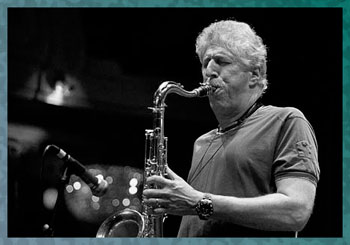 In bars 7-8, over Dm7-G7-Cmaj7, the approach is the same, from the downbeat of bar 7, I am playing in a Db dominant 7th pentatonic [Db, Eb, F, Ab, Cb] area, which is, of course, the b5 sub for G7. Over the Cmaj7 chord, I am playing E minor pentatonic [E, G, A, B, D], a simple approach putting to use the minor pentatonic built upon the major 3rd of the chord. In bars 7-8, over Dm7-G7-Cmaj7, the approach is the same, from the downbeat of bar 7, I am playing in a Db dominant 7th pentatonic [Db, Eb, F, Ab, Cb] area, which is, of course, the b5 sub for G7. Over the Cmaj7 chord, I am playing E minor pentatonic [E, G, A, B, D], a simple approach putting to use the minor pentatonic built upon the major 3rd of the chord.As [D2] arrives, I am playing alterations that again use the sense of the b5 sub, here that's a G major triad, but at the end of bar 1, things become more consonant as the Fb(#9) becomes F-natural(3rd). Because of the dissonance in bar 1, bar 3, over the D7 chord, the lines are much more consonant with some chromaticism, but using A Dorian as the source. Bars 5-8 offer the first bent notes of this particular solo adding a bluesiness to everything. The cadence of the line leading to Abmaj7 functions to me as a delayed resolution, because in the Abmaj7 bar, you are seeing an Eb augmented triad(G-Eb-B) resolving to C-natural. In bar 7, another bent note, and over the Cmaj7 bar, notes from a simple G7 chord are played to cadence to E-natural(3rd). A chordal passage arrives as does letter [E], and this style of voicing, to me, is directly related to the left hand style of McCoy Tyner. One of the things that I love so much about this approach is that over a ii-V, and specifically over the iim7 chord, he often plays a voicing that, in this case indicates more Gb7(13) than Dbm7. The inclusion of that Bb in the voicing really changes everything. So, bars 1-2 are completely in this style. Then, in bars 3-4, we have another ii-V to Abmaj7, but this time, over the ii-V, I am observing both chords individually, as the lines over Bbm7 comes from Bb Dorian [Bb, C, Db, Eb, F, G, Ab], while a C triad(G-E-C) over the Eb7 chord outlines a 13b9 sound before resolving to Abmaj7, and lines that come from C minor pentatonic. For bars 7-8, played in a montuno style, I played the same voicing in parallel that becomes: F7(#9)-Bb7(13b9)-Eb7(#9)-Ab7(13b9). The montuno fiesta continues during [D3], as the superimposition of triads reappears. Obviously, these are sounds that I love exploring in any context, but especially in the context of Latin music. So, over Db7 you hear me using a Db triad to an Eb triad, which adds the colors of: Bb(13th)-G(b5)-Eb(9th). Then up a 1/2-step to D7, and the chords are parallel: a D triad to an E triad. Then, in bars 5-6, as we arrive at the ii-V to Ab major, the triads become: Db triad-Eb triad-F triad-Eb triad. The sounds of the F triad over Ab are key, because normally F-A-C over Eb7 ends up resolving to an Eb triad [Eb(5th)-G(maj7th)-Bb(9th)] over Ab, which gives you a lot of color without using the 3rd(C) of the chord. In bars 7-8 over the ii-V to Cmaj7, the triads ascend to an F triad, before coming back down a 1/2-step to an E triad over the G7, and that E triad(E, G#, B) repeats briefly over C major, before resolving to a rich Cmaj7(6/9) voicing. Simplicity returns with Chorus 2 as a simple Db7 chord is outlined in bar 1. In bar 2, color tones from Ab minor pentatonic [Ab, Cb, Db, Eb(9th), Gb(4th)] are hi-lited. As the D7 chord arrives in bar 3, that chord sonority is outlined by the line. Notice how in each of these three phrases, the lines conclude with a short note on beat 3. The chord formations in bar 4, represent a pianistic left hand style of playing that I will always associate with Chick Corea's playing on Cal Tjader's 1966 Latin Jazz classic, "SOUL BURST," this style of playing ended-up influencing everything that I've done with the guitar in the years since. As the ii-V to Abmaj7 returns in bars 5-6, the descending line reflects Bb Dorian with some chromaticism, and notice the small phrasing mannerism on beat 1! Over the first 2 beats of bar 6, the Abmaj7 chord, the line reflects a delayed resolution as it passes through an A7 chord before landing on the consonant 3rd(C-natural) of Abmaj7. Notice how close together C# and C-natural are. 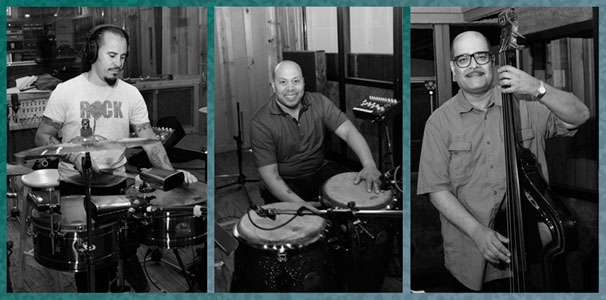 In the first half of bar 7, over Dm7, I am playing A minor pentatonic [A, C, D, E, G], and over the G7 chord in the 2nd half of the bar, you again see notes from the Db dominant 7th pentatonic before we resolve to Cmaj7 in bar 8 with the E minor pentatonic. In the first half of bar 7, over Dm7, I am playing A minor pentatonic [A, C, D, E, G], and over the G7 chord in the 2nd half of the bar, you again see notes from the Db dominant 7th pentatonic before we resolve to Cmaj7 in bar 8 with the E minor pentatonic.The little montuno that I played through both Db7 and D7 in bars 1-4 of [D2] I owe directly to pianist/arranger Oscar Hernández(Spanish Harlem Orchestra) whom I first met while playing softball in Central Park during the '80s. Oscar was always incredibly gracious and helpful to me with all my efforts to understand more and more about the intricacies of Latin music, and, in the end, it was Oscar who introduced me to: Marc Quiñones, Bobby Allende, and Rubén Rodríguez, who all perform so brilliantly on "BACKLOG." I can't tell you all how much I love the sound and feel of Rubén's baby bass on this tune, and anywhere that it appears on this album, and "SUBTEXT" before it. Bars 5-6 and the ii-V to Abmaj7 have the line reflecting both chords, and the Eb7 is treated with a simple Eb augmented triad(G-Eb-B), and that same lower B-natural pulls up to C-natural, and then a sequence of 1-2-3-5 lines that so many players came to associate with John Coltrane and his classic "Giant Steps" solo. Notice how in bar 7, over G7 in the 2nd half of the bar, the ascending line concludes with Bb(13th) going down to Cb(7th), both notes could be considered as part of Db7(13) or G7(#9). Then, to conclude the phrase, I outlined a D major triad over Cmaj7, and resolved that sonority to the consonant note of E-natural(3rd). As the bridge, letter [E] arrives, over each of these ii-Vs, I am using the corresponding minor pentatonic, to my way of thinking. So, over Dbm7-Gb7, you hear Db minor pentatonic [Db, Fb, Gb, Ab, Cb]. And over the Dm7-G7, you hear D minor pentatonic [D, F, G, A, C]. Notice that, as the rhythms of the phrase shift, in bar 2, I end the phrase with long-short articulation. In bar 3, over the ii-V to Abmaj7, in the first half of the bar over the Bbm7 chord, what I'm really doing with my line is implying a brief sense of Bb7(V7 of V7), and over Eb7, I am using E Dorian [E, F#, G, A, B, C#, D], which is the ii chord of the b5 sub(A7) for Eb7. A bit of a sideways linear approach to the eventual resolution on Abmaj7, where the 1-2-3-5 linear configuration reappears beginning on the 5th(Eb) of the chord. In bars 5-6 over both Dbm7-Gb7 to Bm7-E7, the chord reflect the same harmonic style, somewhere between Tyner and the young Corea, and this is consistent with the way that I approach harmony. In bars 7-8, as the section concludes with a cycle of dominant 7th chords, I again return to the 1-2-3-5 linear idea, but beginning on F-natural. I then go up a b5 to B-natural, up a 4th to E-natural [each one 1/2-step above the actual chord], and finally descend in this linear pattern from a high Db: Db-Bb-Ab-Gb that resolves right to F-natural, the 3rd of Db7 as the new section arrives! I believe that I heard Bob Mintzer do something like this somewhere during his solo! Again, you want to be connected to things that have happened before, while moving the piece forward! The last section of Chorus 2, [D3], begins with line configurations using the dominant 7th pentatonic for both Db7 and D7, but notice how the two phrases over Db7 are both ascending, and the first phrase over D7 is descending, only to ascend again in bar 4 with a line that is the same configuration that began this phrase, but varied rhythmically. In bar 5, over the ii-V to Abmaj7, I again skip over the iim7(Bbm7), and I am playing immediately in the area of Eb7(alt.). The first half of the bar outlines Eb7(13b9), and the 2nd half of the bar outlines the b5 sub with an A triad. As the line resolves to Abmaj7, I am using the C minor pentatonic with G-natural serving as my pivot tone between Eb7 and Ab major. It is, after all, present in both chords! The treatment of Dm7-G7 in bar 7 is initially more consonant as I spell out the guts of the chord with an F triad [C(7th)-F(m3rd)-A(5th)], and then I break-up a Db7 chord, the b5 sub of G7. The resolution arpeggiates a simple Cmaj7 chord, but the phrase finished nicely on an A-natural, the 6th of this harmonic area! A return to material, both melodic and rhythmic, from Ornette's melody for "Invisible" begins Chorus 3, the final chorus of the solo. Over the Db7 chord, the lines really come from two sources: [1] Db dominant 7th pentatonic, and [2] Ab minor pentatonic. But over the D7 chord in bars 3-4, the approach is a bit different, and you hear: [1] A minor pentatonic, and [2] B minor pentatonic [B(13th), D, E(9th), F#, A]. These cerebral details are never thought out, they just happen in the flow of playing, and any analysis only comes much later. In bar 5, over the ii-V to Abmaj7, I am playing F minor pentatonic [F, Ab, Bb, C, Eb], and then the triad motif slides up to an A triad, the b5 sub, over the Eb7 chord. This is followed by two chordal punctuations over Abmaj7, the first is actually an Abm7(sus) that, while keeping Eb on top, the 4ths resolve downward to form an Abmaj9(6) voicing. Over the Dm7-G7 chords in bar 7, the line is chromatically drawn from D Dorian, but the last two notes Db-G reveal a sense of the b5 sub. As the line resolves to Cmaj7, the configuration of notes is from that small 3-note chord formation: A-D-E. As [D2] arrives, it's montuno time again. This one I also love, because it employs simple but majestic sounding triads. So, over Db7, while sustaining a high Db, you have a Cb triad moving to a Db triad, and back. 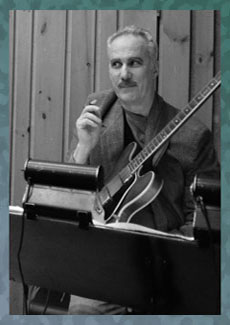 As we go up a 1/2-step for bars 3-4 to D7, I am playing the same thing. During these bars, you can hear and feel drummer Mark Walker's intensity level picking up! These chordal formations are something that I learned to play from listening to Chick Corea's solo vamp on the tune "Soul Burst." From there we have chordal punctuations over the ii-V to Abmaj7. The chord formations over bar 6 and the Abmaj7 chord, are parallel with a nice open shape: Bb(9th)-Eb-F(6th)-Bb to C-F(6th)-G(maj7th)-C. Needless to say, I like these kinds of chordal soundshapes very much. Once again, in bar 7, I am ignoring the iim7 chord(Dm7), and playing lines that immediately allude to G7(alt.). And, as I pass down through the notes of a Db7 chord, the low Ab slides right into G-natural as the cadence to Cmaj7 arrives in bar 8. As we go up a 1/2-step for bars 3-4 to D7, I am playing the same thing. During these bars, you can hear and feel drummer Mark Walker's intensity level picking up! These chordal formations are something that I learned to play from listening to Chick Corea's solo vamp on the tune "Soul Burst." From there we have chordal punctuations over the ii-V to Abmaj7. The chord formations over bar 6 and the Abmaj7 chord, are parallel with a nice open shape: Bb(9th)-Eb-F(6th)-Bb to C-F(6th)-G(maj7th)-C. Needless to say, I like these kinds of chordal soundshapes very much. Once again, in bar 7, I am ignoring the iim7 chord(Dm7), and playing lines that immediately allude to G7(alt.). And, as I pass down through the notes of a Db7 chord, the low Ab slides right into G-natural as the cadence to Cmaj7 arrives in bar 8.There is a nice 3-note pick-up that slides into letter [E], and the line with some chromaticism. Notice how the target note of Ab is surrounded by upper and lower neighbors that hi-lite its arrival. Apart from the chromaticism, bar 2, Dm7-G7, stays very consonant. For bars 3-4, and the ii-V to Abmaj7, once again, triads outline the path as we pass through an Ab triad over the Bbm7 chord, and a Gb triad over the Eb7(alt.) chord, leading us to resolution on a C-natural over the Abmaj7 chord. Pay attention to how the C is repeated, but only after both of its consonant upper and lower neighbors have surrounded it. To me, this is a common linear device, but always effective. Chordal punctuations reappear in bars 5-6, and over Dm7-G7 and Bm7-E7, the iim7 chords are ignored and I am playing chords from the dominant areas only. With Rubén Rodríguez and his ever present baby bass laying down a big tumbao, this device is always going to sound good. Finally, in bars 7-8, and the cycle of dominant 7th chords, both lines initially hi-lite notes from F7(alt.): Ab(#9) to Gb(b9), and from Eb7(alt.): Gb(#9) to Fb(b9), but on the latter, on beat 3, there is a resolution to the Ab7 chord by playing the guide tone notes: C-Gb - played long-short!!! The montuno that begins the final [D3] section of the solo section was my little tribute to the song "Sisé," which appeared on the "PUBLIC ACCESS"(GRP) album from 1989. Over both the Db7 and D7 chords, my open E-string becomes the note that glues this feel together harmonically and rhythmically. The chords continue through bars 5-6 with that same open sounding configuration: Ab-Eb-F-Ab, and that first voicing is often associated with being part of a Bbm7(sus) chord. This ascends parallel with the top voices being: Ab-Bb-B-C, and it resolves to C-F-G-C over Abmaj7. Over the Dm7 chord in bar 7, I am only playing a simple F triad, but how refreshing that simple sound is after all the more sophisticated harmonies offered just before it! Finally, over the G7(alt.) chord, I am passing through a Db7 arpeggio, with the last note of Ab sliding down into a G-natural and the Cmaj7 chord. The last voicing on beat 4 is a more standard guitar voicing, spelling up: A(6th)-D(9th)-G-B(maj7th), and you can see all the color tones that are included. My friendship and musical association with the great Rob Mounsey now spans some 40 years. It is hard to believe, sitting on this end of the time spectrum, that it has actually been that long. We have contributed to each other's projects, and made two wonderful recordings together as well: "LOCAL COLOR"(1987) and "YOU ARE HERE"(1998). I treasure both of them. Rob's contributions to my recordings, beginning in 2005 with "THE GREEN FIELD" have been immense. In the end, I could not have done any of them without his help, guidance, voice of sanity & supreme musicality. On "BACKLOG," the increased importance of Rob's keyboard role became a huge part of this album. His work on "Invisible" was so important to the overall sound and feeling of this piece. I don't believe that I have ever posted the KEYBOARD LEAD SHEETS for anything of mine that might have appeared at KHAN'S KORNER 1, so this is a first. But, I thought that, for those of you who might be interested in such things, you can actually see what I wrote out for Rob, and then hear exactly how beautifully he played all those parts. 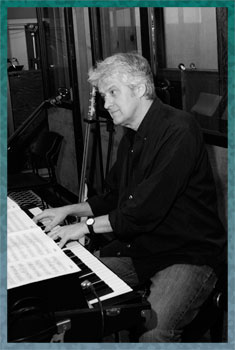 For me, working closely with a musician of Rob's talent level, it is important to not be wasting his time with my own uncertainty about what I might need from him on the keyboard. So I spend a great deal of time working things out at home before I present him with anything. Then, once he has the parts, and we've discussed them, should questions arise, he can contact me, and we can work out whatever the problem might be. It can be as small as a badly written accidental, or something more complex. In the end, I value Rob's opinion so much that I'm grateful for anything that he has to say. Fortunately for me, where "Invisible" was concerned, very little changed from what I presented him with. For those of you who choose to investigate these lead sheets, I hope that you will discover something more about Rob's artistry and great musicianship. For me, working closely with a musician of Rob's talent level, it is important to not be wasting his time with my own uncertainty about what I might need from him on the keyboard. So I spend a great deal of time working things out at home before I present him with anything. Then, once he has the parts, and we've discussed them, should questions arise, he can contact me, and we can work out whatever the problem might be. It can be as small as a badly written accidental, or something more complex. In the end, I value Rob's opinion so much that I'm grateful for anything that he has to say. Fortunately for me, where "Invisible" was concerned, very little changed from what I presented him with. For those of you who choose to investigate these lead sheets, I hope that you will discover something more about Rob's artistry and great musicianship.Though it has absolutely nothing to do with the solo on "Invisible," I wanted to share one more little story about the crafting of this arrangement. Believe or not, whether a tune is going to have a Fade for an ending, or a real ending, these final details are all very carefully thought out. In most cases, I would prefer to have written and arranged an actual ending, but sometimes, for purely musical reasons, a Fade seems like the best choice. For Ornette Coleman's "Invisible," I had crafted an ending, but there was a bit of space, before the final hit, and I was hoping that Marc Quiñones would come-up with a clever way to fill the space. In cut-time, there were only 6 beats to fill. Before our one rehearsal, I began to remember Willie Bobo's incredible timbal fill at the end of his hit tune "Spanish Grease"(Verve) from 1965. I especially love the way he integrated the foot/kick drum into the fill. It is just too damn funky!!! With the help of an easy Pro Tools edit, I brought in a little soundclip of that ending, and played it for Marc, Bobby Allende and Mark Walker, and together they crafted a way to pay a small homage to the great Willie Bobo, and this one little moment of his funky brilliance from long, long ago. For some crazy reason, I remember many little details like this from musicians and the recordings that I have loved. So, this was my way of playing "music fantasy" and bringing it into my own little crazy reality. I thank Marc, Bobby and Mark for putting-up with this aspect of my creative insanity, and for making it happen.
[Photos: Ornette Coleman & Don Cherry
Bob Mintzer Photo by Dragan Tasic Collage: Marc Quiñones - Bobby Allende - Rubén Rodríguez Photos by: Richard Laird Steve Khan @ Avatar Studios Photo by: Adela Blanco] |